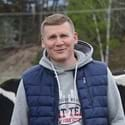75
Friesian Holstein dairy cows
When Adam took over the farm from his parents, he applied for grant funding to invest in new facilities. This financial support went toward the development of a new barn and robotic milking facilities, dramatically improving cattle comfort and time management on the farm.
Adam’s family purchased the farm in Gajewo, Poland, in 1972. It covers a total area of 72 hectares (178 acres) and is home to a dairy herd of 75 Friesian Holstein cows. After graduating from the University of Life Sciences in Poznań, Poland, and after living for a time in the UK, Adam took over managing the day-to-day running of his family farm.
His goal for the farm is to focus on innovation and technology to improve animal welfare and increase efficiency on the farm. It is this commitment that has won him several accolades from the local community and the dairy cooperative he supplies.



Kernbereiche der Nachhaltigkeitspraxis
By moving to a system of robotic milking, the farm has removed the need to milk the cows twice daily. This has allowed Adam to reallocate that time for other farm or family needs and has also reduced staffing requirements by half of a full-time labor unit.
Adam has invested in several systems to improve cattle well-being. The robotic milking system can be tailored to an individual cow’s yield and lactation stage, allowing a tailored milking regime for the cow. The system is also designed to reduce over-milking, decreasing the risk and occurrence of mastitis. A cow-activated mechanical brush, as well as outdoor access to a pasture loafing area for all cows, encourages natural behaviors in the cattle, while free-access stalls fitted with rubber matting and covered with sawdust offer a soft, thermally comfortable area for cows to lie down.
To ensure good health, all cows are provided with a total mixed ration (TMR) that covers their nutrient requirements and supports the production of 24kg (53lb.) milk. Cows are provided with additional feed based on their yield and lactation stage. Weekly footbaths are provided to help reduce and prevent the incidence of lameness.
Adam regularly gives lectures to help share his best practices, as well as attending technical meetings, field days and demonstrations to develop his own technical knowledge.
He is part of Inno4Grass, a three-year project funded by the European Union’s Horizon 2020 fund. The project was designed to bridge the gap between science and the development of new farming practices. By ensuring innovative systems are implemented on productive pasture farms, the project aims to increase farm profitability while preserving the environmental value of grasslands.
Adam works closely with the local council to identify ways the farm can support the community.
By equipping each cow with a neck transponder programmed with their unique identification, the farm ensures cattle are fed and milked according to specific requirements. The transponder also records activity levels, which helps in the detection of oestrus. By monitoring these factors, cows can be more easily identified for insemination, ensuring a higher rate of reproductive success.
Female sexed semen is used on maiden heifers. Heifers are more fertile and generally of the highest genetic merit, so sexed semen helps to accelerate genetic progress and the cost benefit of producing a dairy female over a dairy male is also considerable.
Learn more about Adam’s story at Warnke Farm
Explore the case study, where you’ll find additional details on how Warnke Farm has aligned with the Flagship Farmers Program’s key areas of sustainable practices, what external research reveals about the producer’s actions and how improved sustainability is benefiting them.






